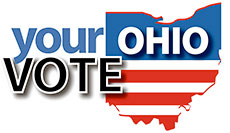The Informed Citizen Akron Citizens Jury reconvened at 8:30am on June 3rd to continue the work they had begun the prior day. Each smaller group shared the questions they had for media, discussed ideal media coverage, and identified obstacles to effective issue coverage many media organizations are likely facing.
The day transitioned to presentations from media experts working on improved coverage and community engagement. For each presentation, participants were asked to consider how Ohio media can provide better information to voters so that they can make more informed choices in their daily lives. The first presenter was Jake Batsell, author of Engaged Journalism: Connecting with Digitally Empowered News Audiences. Batsell provided an overview of some ways media can engage their audiences and communities. Batsell noted that improved engagement relates to increased revenue and a more engaged audience.
Fiona Morgan of Free Press joined the group to illustrate the value in media organizations engaging with the community to identify their needs and prioritize the most marginalized voices in the community. Free Press approach generally involves organizing in-person events and working on behalf of media partners to understand the community in which they operate in a more meaningful way.
Ellen Mayer, Community Manager for Hearken, highlighted her work with newsrooms to better frame coverage around community needs. Hearken helps solicit questions from the public for newsrooms to explore, with the public subsequently voting on the questions they want answered most. This citizen-driven coverage generally outperforms more traditional types of reporting. This citizen-driven approach to story creation and issue framing rose to the top for jurors based on the capacity to create more relevant and resonant issue coverage.
Michelle Ferrier of Journalism That Matters shared her case for engaged journalism as the only way for legacy newsrooms to succeed in the changing media ecosystem. Ferrier displayed a map of Ohio and, using GIS information, demonstrated the existence of media deserts, or communities that lack traditional journalism resources and outlets. These media deserts are often found in less affluent communities that may lack the wealth or appeal to advertisers to sustain traditional media organizations. These underserved, often rural, communities are at once disadvantaged for their lack of access to information while being one of the most potentially engaged communities. The conditions required to engage these individuals require innovation and outreach; both of which require a diversion of resources by media organizations. Jurors connected with the value of improving relationships with rural communities, with the goal of creating engaged and loyal consumers. Dr. Ferrier also outlined principles for effective media-led engagement and collaboration.
The final expert presentation was given by Andrew Haeg of Groundsource, which pushed jurors to imagine journalism with a less-traditional approach. The idea of citizens using text messages to report from the ground to news sources was mentioned by many as valuable for its ability to meet people where they are and imagine a different type of news contribution by citizens.
Following these presentations, citizens identified guiding principles and strategies mentioned in the presentations along with the advantages and challenges associated with these types of engagement. The jurors were then given the opportunity to craft initial statements they’d like to share with journalists based on what they learned, as well as information they would want their neighbors who aren’t in the room to know about journalists. These statements ranged from statements empathizing
with what it is like to be a reporter, to suggestions that newspapers not accept funding that might create conflicts of interest.
The jury was excused to reconvene Saturday, June 4th.
